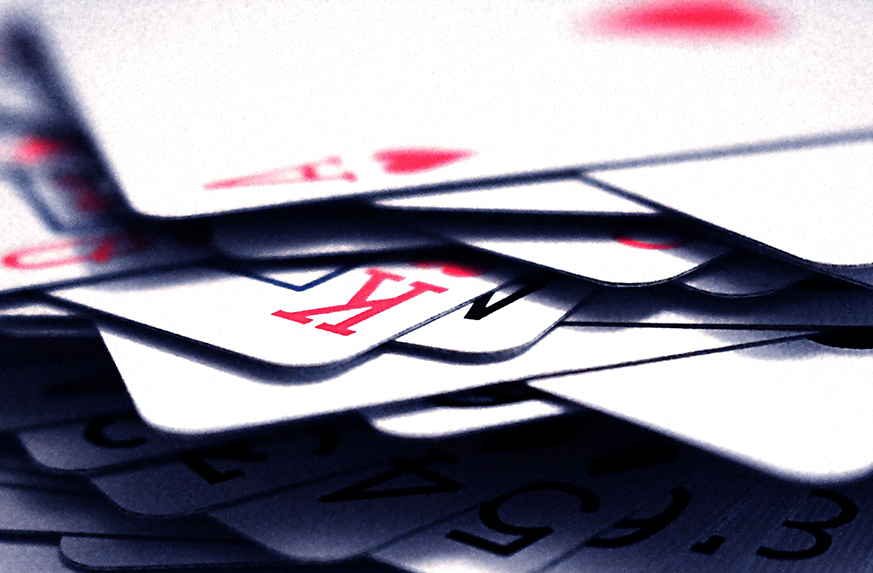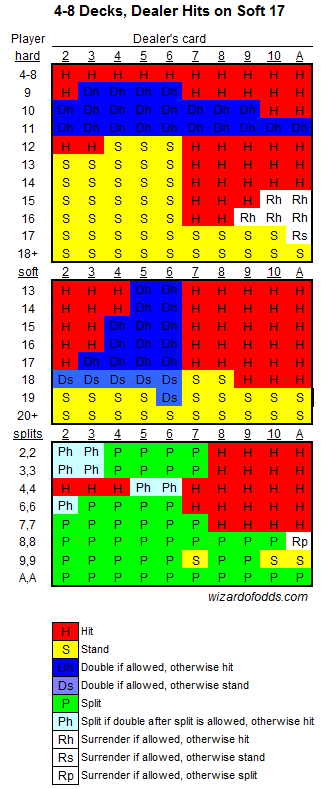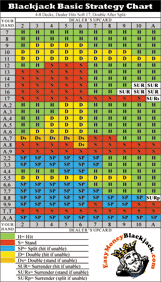Blackjack Odds Basic Strategy

- How To Win At Blackjack Basic Strategy
- Blackjack Basic Strategy Odds Of Winning
- Blackjack Basic Strategy Test
- Blackjack Perfect Basic Strategy Odds
- Blackjack 6 Deck Basic Strategy Chart
- The basic strategy is important since it can increase your chances of winning this game. Professionals came up with the best way to play each hand to get the best blackjack odds. They took their time to analyze how a particular number of blackjack decks could affect the chances of winning in a blackjack.
- By using correct blackjack basic strategy, you can turn the casino edge in blackjack from 7%-8% down to 0.5%. If you correctly use advanced card counting techniques, you can often change blackjack odds and give yourself the advantage over the casino.
- Use basic blackjack strategy. Without basic strategy you’re playing at an 8% disadvantage. With strategy, however, the odds increase significantly. You’ll be playing at only.5 to 1.5% disadvantage. Find the best games. The rules make all the difference. For example, if you play a 6:5 blackjack game you’re adding a 1.39% disadvantage.
- Basic strategy is a mathematically calculated set of decisions that can help you win more at blackjack. The Blackjack Basic Strategy Engine above provides a simple way to memorize a variety of different profitable decisions, such as when to split, double, surrender, hit, or stand.
The Blackjack Basic Strategy Chart. The Blackjack basic strategy chart is one of the most essential things for any blackjack player. As the strategy recommends only the best decisions from a mathematical point of view, the blackjack strategy chart is the table that contains all the solutions recommended by blackjack basic strategy.
US Players and Credit Card, BitCoin Deposits Accepted!
Blackjack Probability and Blackjack Odds
To fully understand the game of blackjack, you must understand and master blackjack odds. It's crucial to know how the casino gains its edge and how it helps them win. It's also important to understand blackjack odds such as the odds of hitting a 10 or the odds of being dealt a blackjack. You can read over these blackjack odds charts to help understand the logistics behind blackjack.
Casino and Dealer Advantage in Blackjack
In most casino games of blackjack, the house advantage (the dealer advantage) is ~ 8%. The house gets this advantage by the dealer being the last player to act. By acting last, all other players have already made their decisions and could quite possibly bust before the dealer has his turn.
By using correct blackjack basic strategy, you can turn the casino edge in blackjack from 7%-8% down to 0.5%. If you correctly use advanced card counting techniques, you can often change blackjack odds and give yourself the advantage over the casino. Manipulating the house odds to your favor is the reason most casinos don't allow card counters to play blackjack.
How To Win At Blackjack Basic Strategy
Probability of Busting on a Hit
It's very important to know the probability of your hand busting when you are holding any total in the game of blackjack. The following odds chart shows the blackjack odds of busting, depending on your current hand value:
| Hand Value | % Bust If You Hit |
|---|---|
| 21 | 100% |
| 20 | 92% |
| 19 | 85% |
| 18 | 77% |
| 17 | 69% |
| 16 | 62% |
| 15 | 58% |
| 14 | 56% |
| 13 | 39% |
| 12 | 31% |
| 11 or Less | 0% |
Two-Card Count Frequencies

This interesting blackjack odds chart is the two card count frequency chart. This chart shows the percentage chance that you will be dealt a hand in each given value range. The most important frequencey to note is the chance of being dealt a natural blackjack (natural 21 value. The odds of being dealt a natural blackjack are merely 4.8%. Following this chart you will see that the most common two card hand, at 38.7%, is a hand totaling 1-16, which is considered a decision hand.
| Two Card Count | % Frequency |
|---|---|
| Natural 21 | 4.8% |
| Hard Standing (17-20) | 30.0 % |
| Decision Hands (1-16) | 38.7% |
| No Bust | 26.5% |
| TOTAL | 100.0% |
Dealer Final Hand Probabilities
This blackjack odds chart shows the dealer final hand probability. These are the percentages that the dealer will end up with a hand totaling each corresponding value (up to 16). Read over this chart to understand the odds that the dealer has to make his final hand.
| Dealer Final Hand Value | % | Cumulative % Total |
|---|---|---|
| Natural 21 | 4.82% | 4.83% |
| 21 (3 or More Cards) | 7.36% | 12.19% |
| 20 | 17.58% | 29.77% |
| 19 | 13.48% | 43.25% |
| 18 | 13.81% | 57.06% |
| 17 | 14.58% | 71.64% |
| 16 | 28.36% | 100.00% |
Player Advantage vs. Dealer Up Card
The first two columns in this odds chart explain the dealer's chance of busting, depending on the up card that he is showing. You should note that the dealer has the highest chance of busting when he is showing a 5. The third column in this chart shows the player advantage of using basic strategy, compared to each up card the dealer is showing. You can see that the player has the highest advantage of 23.9%, when the dealer is showing a 5. When the dealer is showing any card that is 9 value or higher, the player is in the negative advantage range.
| Dealer Up Card | Dealer Bust % | Player Advantage % with Basic Strategy |
|---|---|---|
| 2 | 35.30% | 9.8% |
| 3 | 37.56% | 13.4% |
| 4 | 40.28% | 18.0% |
| 5 | 42.89% | 23.2% |
| 6 | 42.08% | 23.9% |
| 7 | 25.99% | 14.3% |
| 8 | 23.86% | 5.4% |
| 9 | 23.34% | -4.3% |
| J,Q,K | 21.43% | -16.9% |
| A | 11.65% | -16.0% |
Effects of Removing Cards from a Deck
When looking at the odds of removing certain cards from a 52-card deck, some cards have a much greater effect on blackjack odds. To create the strongest card counting system ever invented, you would have to incorporate all of these slight and subtle differences into the numbers to be a completely accurate system.
Removing every 5 from a deck cards would make the largest impact of improving your blackjack odds, as a player. On the other hand, removing every Ace from a deck of cards would make the largest impact on improving the odds for the casino.
| Card | % Effect of Removal |
|---|---|
| 2 | 0.40% |
| 3 | 0.43% |
| 4 | 0.52% |
| 5 | 0.67% |
| 6 | 0.45% |
| 7 | 0.30% |
| 8 | 0.01% |
| 9 | -0.15% |
| 10 | -0.51% |
| A | -0.59% |
See also:
US Players and Credit Card, BitCoin Deposits Accepted!
Blackjack (also known as twenty-one or sometimes pontoon) is one of the most popular casino card games in the world. The name blackjack comes from the fact that when blackjack was first introduced in the U.S. it wasn't very popular, so casinos and gambling houses tried offering different bonus payoffs. One of those was a 10-to-1 payoff for a hand consisting of the ace of spades and a black jack (that is, the jack of spades or the jack of clubs). With the current rules, a blackjack hand doesn't even need to contain a jack.
Rules
A blackjack game has a dealer and one or more players. Each player plays against the dealer. All players are initially dealt two cards and the dealer is dealt one card face down and one face up (these are called the hole card and up card respectively). Each player can then hit (ask for an additional card) until her total exceeds 21 (this is called busting) or she decides to stand (stop taking cards for the rest of the hand). Face cards count as 10 and an ace may be counted as 1 or 11. After all of the players have finished, the dealer reveals the hole card and plays the hand with a fixed strategy: hit on 16 or less and stand on 17 or more.
The player loses if she busts and wins if she does not bust and the dealer does (observe that if both the player and the dealer bust, the player loses). Otherwise, the player wins if her total is closer to 21 than the dealer's. If the player wins, she gets twice her bet; if she loses, she loses her money. If the dealer and player tie it is called a 'push;' the player keeps her bet but does not earn any additional money. If the player's first two cards total 21, this is a blackjack and she wins 1.5 times her bet (unless the dealer also has a blackjack, in which case a tie results), so she gets back 2.5 times her bet.

Soft Hand. A hand that contains an ace that can be counted as 11 is called a soft hand, since one cannotbust by taking a card. With soft hands, the basic strategy is to always hit 17 or less and even hit 18 if the dealer's up card is 9 or 10 (where the 10 refers to a 10, J, Q, or K).
Doubling down. After the player is dealt her initial two cards she has the option of doubling her bet and asking for one additional card (which is dealt face down). The player may not hit beyond this single required card. With the basic strategy, you should always double with a total of 11, double with 10 unless the dealer's up card is 10 or A, and double with 9 only against a dealer's 2 to 6. (Some casinos only allow doubling down on 11).
Splitting pairs. At the beginning of a hand, if the player has two cards with the same number (that is, a pair) she has the option of splitting the pair and playing two hands. In principle, a pair of aces should of course be split, but in this case blackjack rules allow you to get only one card on each hand, and getting a 10 does not make a blackjack. With the basic strategy, you should never split 10's, 5's or 4's, always split 8's, and, in the other cases, split against an up card of 2 to 7, but not otherwise.
Strategies for the Player
Blackjack is almost always disadvantageous for the player, meaning that no strategy yields a positive expected payoff for the player. In the long run, whatever you do, you will on average lose money. Exceptions exist: some casinos offer special rules that allow a player using the right strategy to have a positive expected payoff; such casinos are counting on the players making mistakes.
The so called basic strategy is based on the player's point total and the dealer's visible card. It consists of a table that describes what you should do in any situation in the game (you can find an example of this table at Wikipedia). Under the most favorable set of rules, the house advantage against a player using the basic strategy can be as low as 0.16%.
Blackjack Basic Strategy Odds Of Winning
Many people assume that the best strategy for the player is to mimic the dealer. A second conservative strategy is called never bust: hit 11 or less, stand on 12 or more. Each of these strategies leads to a player disadvantage of about 6%.
Edward Thorp, in his 1962 book Beat the DealerBlackjack Basic Strategy Test
, describes a simple strategy that makes blackjack an almost even game: if the dealer's up card is 2 to 6, play never bust; if it is 7 to ace, mimic the dealer. The exception to this simple rule is that one should hit a 12 if the dealer's up card is 2 or 3. More advanced strategies include features such as taking into account the player's hand composition (as opposed to just considering the point total) and the other players' hands, specially card counting (that consists of keeping track of the cards that have been dealt so as to know the composition of the remaining cards in the deck), and shuffle tracking (which is far more complicated than card counting, and consists in roughly following groups of cards as they are shuffled). These two last strategies are usually forbidden in casinos.What does it mean to have a 0.16% disadvantage?
When discussing casino games, one usually finds statements such as the ones above saying something like: 'the house advantage in this game is about 0.16%'. A first explanation is the following: betting ten dollars each hand, you will in the long run lose an average of 1.6 cents per hand. It would be nice to have an idea of the probability of winning any particular bet when playing some specific strategy. Indeed, we can infer this from the player's disadvantage. Let's take, as an example, the potential 0.16% disadvantage when playing the basic strategy.
Suppose you bet $1 at each of 10,000 bets playing the basic strategy. Let's call p the total probability of winning a pass line bet (so p is the number we are trying to calculate). If p was, for example, 0.5, it would mean that, on average, half the times you should win the bet, so you would win 0.5 · 10,0000 = 5,000 times. Since each time you win a bet you get twice what you bet and each time you lose the bet you lose all the money, you would end up with 5,000 · $2 = $10,000, that is, the same total amountyou bet (10,000 times $1). In this case, the house advantage is 0%, as is the player advantage.
The same idea applies for any p: if you bet 10,000, you should, on average, win the bet 10,000p times, so your average payoff is $20,000p. In our case, the house advantage is 0.16%, so if you play $10,000, on average you end up with $10,000 - $10,000 · 0.0016 = $10,000 - $16 = $9,984. So we only have to solve the equation $20,000p = $9,984 to get p = 0.4992.

Links
You can find more information on blackjack's rules, strategies, and history on the Internet. For instance, you can try Wikipedia.
A very interesting free on-line blackjack trainer can be found here.
Blackjack Perfect Basic Strategy Odds
- If you are dealt a point total of 16, what is the probability of busting if you hit, assuming that a whole deck will be used to choose among when you are dealt your next card?
- If you are dealt a 3 and an ace, what is the probability of not busting if you hit, assuming that a whole deck will be used to choose among when you are dealt your next card?
- Suppose you are the only player against the dealer, and you are in the first hand of a game played with one deck. You are dealt an 8 and a 6, while the dealer is showing a queen. What is the probability that you bust if you decide to hit?
Blackjack 6 Deck Basic Strategy Chart
| Solutions | Return to Lesson Index | Top of Page |